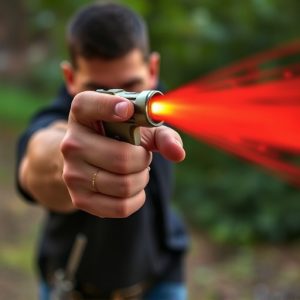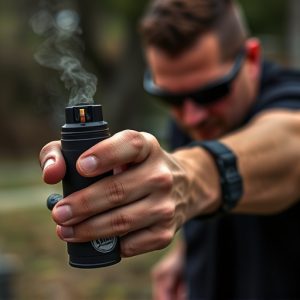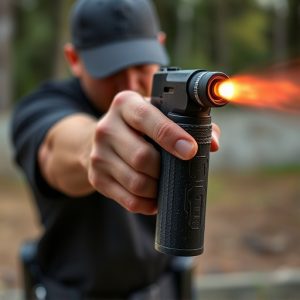Neutralizing Pepper Spray: Devices, Safety, and Removal Techniques
Pepper spray, a non-lethal riot control tool using capsaicin, temporarily incapacitates individuals…….
Pepper spray, a non-lethal riot control tool using capsaicin, temporarily incapacitates individuals during civil unrest. Its effects subside without lasting harm, allowing de-escalation or escape. While targeting faces is controversial due to safety risks, law enforcement defends its use in high-intensity situations with proper training and protocols. Specialized dispensing devices ensure accurate targeting, ergonomic handling, and adaptable spray distribution for effective riot control. Quick neutralization of pepper spray on the face involves flushing with water, mild soap, and seeking medical attention for eye exposure to prevent long-term damage.
“Uncovering the tools of modern riot control, this article delves into the inflammatory riot control spray dispenser—a powerful yet controversial device. We explore its composition, effects, and safety implications, focusing on the targeted use of pepper spray on the face. From dispensing devices’ design to neutralizing strategies for skin and eyes, we provide insights into effective, yet responsible, riot control practices, emphasizing the importance of understanding how to mitigate its impact. Learn about de-escalation techniques and safe handling of such powerful tools.”
- Understanding Inflammatory Riot Control Spray: Composition and Effects
- Targeting the Face: Safety Considerations and Efficacy of Pepper Spray
- Dispensing Devices: Design Features for Effective Riot Control
- Neutralizing Strategies: Removing Pepper Spray from the Skin and Eyes
Understanding Inflammatory Riot Control Spray: Composition and Effects
Inflammatory riot control spray, also known as pepper spray, is a non-lethal weapon designed to temporarily incapacitate individuals during civil unrest or violent situations. Its primary active ingredient is capsaicin, the same chemical that gives chili peppers their heat and pungent odor. When deployed, the spray creates a burning sensation and causes the eyes to water, leading to temporary blindness and significant discomfort. This effect neutralizes pepper spray on the face, allowing individuals targeted by the spray to temporarily escape or de-escalate the situation.
The composition of riot control spray varies slightly depending on the manufacturer and intended use. Besides capsaicin, some formulations include other chemicals like pepper oil, which enhances the spray’s effectiveness. The spray is delivered through a specialized dispenser, typically in the form of an aerosol can, allowing for quick deployment. The effects are designed to subside after a few minutes, providing enough time for law enforcement or security personnel to control the situation and ensure public safety without causing lasting harm.
Targeting the Face: Safety Considerations and Efficacy of Pepper Spray
Targeting the face with neutralizing pepper spray is a controversial tactic employed by law enforcement and riot control units. While it aims to temporarily disable individuals, safety considerations are paramount. Direct application on the eyes, nose, and mouth can cause severe irritation, pain, and even long-term damage. The efficacy of pepper spray in this context also varies based on factors like distance, weather conditions, and individual sensitivity.
Despite these challenges, law enforcement agencies argue that targeted face sprays offer a quicker response than non-face options during high-intensity situations. However, proper training and protocols are essential to ensure minimal harm to both officers and civilians. Effective implementation involves accurate aiming, adequate distance, and knowledge of de-escalation strategies to avoid unnecessary injuries.
Dispensing Devices: Design Features for Effective Riot Control
In the realm of riot control, effective dispensing devices are paramount to neutralizing and managing chaotic situations. The design features of these tools play a crucial role in ensuring their success during high-pressure events. One key aspect is the mechanism for delivering pepper spray or other irritants directly onto an individual’s face. Advanced dispensers employ precision nozzles that can accurately target specific areas, minimizing off-target effects and reducing collateral damage.
Additionally, ergonomic design considerations are essential to accommodate various user sizes and ensure easy handling in stressful conditions. Lightweight materials and compact forms factor contribute to operator agility, allowing for swift deployment and precise aiming. Moreover, the integration of advanced sensors and pressure regulators can adapt to different scenarios, ensuring optimal spray distribution and enhancing the overall effectiveness of riot control efforts while focusing on safely neutralizing pepper spray on faces.
Neutralizing Strategies: Removing Pepper Spray from the Skin and Eyes
When facing a pepper spray attack, one of the primary concerns is neutralizing its effects as quickly as possible. The first step in removing pepper spray from the skin and eyes is to flush the affected areas with plenty of clean water. This helps to dilute the chemical agent and reduce its irritation. It’s crucial to do this within a few minutes of exposure, as prompt action can significantly alleviate discomfort.
For the face, gently washing with mild soap and water can further assist in neutralizing pepper spray on the skin. In cases where the eyes are affected, flushing them with clean water for at least 15 minutes is recommended to ensure the chemical is thoroughly rinsed out. Seeking immediate medical attention is also advised, as eye exposure to pepper spray can cause severe irritation and potential long-term damage if not properly treated.
In conclusion, understanding inflammatory riot control spray, its composition, and effects is key to effective riot management. Targeting the face with pepper spray requires careful consideration of safety and efficacy. Dispensing devices designed for robust performance can significantly enhance control. Additionally, knowing how to neutralize pepper spray on the face, including removal from skin and eyes, is crucial for minimizing harm and facilitating rapid recovery. These strategies collectively contribute to the safety of both officers and civilians in high-tension situations.


